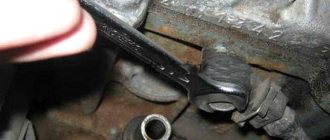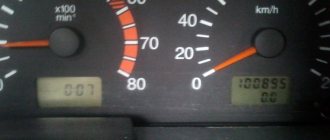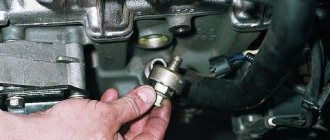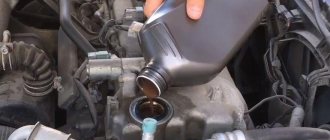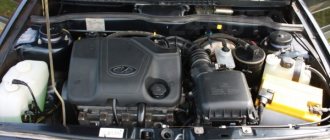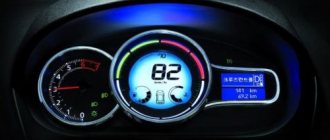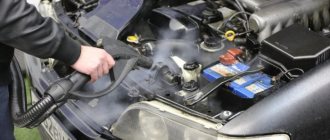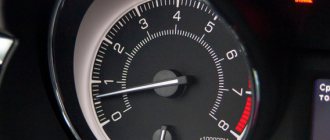Signs of a malfunctioning knock sensor. Check and replace at home. (Part 1)
Good day, friends.
I was often asked questions about this device, so in today’s article I would like to answer you the most frequently asked questions about this. After all, many car owners believe that a malfunction of the knock sensor does not interfere with the operation of the engine in any way, and in some ways they are right, but as always there is one BUT - over time, this malfunction will lead to the failure of other systems and mechanisms of this circuit. And this is much more waste on repairs than checking and, if necessary, replacing the knock sensor. But not everyone knows that in order to check and replace it is not necessary to go to a service center and ask for help from specialists, who most often have a level of knowledge in this area equal to yours and, in fact, will do a not so difficult job for which they will demand a tidy sum from you (I am now I don’t want to make anyone look stupid, it just happened to me personally in life). So, I just want to convey to people that all these procedures with a sensor are done very simply and do not require huge investments and waste of time. The main thing in this matter: 1) Perseverance; 2) Attentiveness; 3) Accuracy; 4) Well, hands from the place that God gave us)
Well, let's start with the basics.
What is a knock sensor? But here everything is simple - this is a part (part) of the control system that is responsible for controlling the level of detonation. Where can I find it? Everything is easy here too - we look on the engine cylinder block. Friends, just don’t get confused and don’t look for it on carburetor engines
. This sensor is installed on injection-type gasoline engines (where there is an electronic ignition system) and specifically on the engine body. The size of this part (if anyone hasn’t seen it) is literally proportional to the size of a matchbox.
It should also be noted that thanks to this device it becomes possible to save fuel
and the ability of the motor
to develop maximum power. The knock sensor regulates the vehicle's starting system and its operation.
In modern cars, as you know, you can see the operation of the sensor on the instrument panel and if there is a malfunction, the indicator will let you know about it.
(CHECK)
So, let’s now look at the operating principle of this device.
It consists of a piezoelectric mechanism (there is a plate inside that has a piezoelectric effect). So, when that same detonation occurs, voltage appears at the output and input. The result is engine vibration. A so-called potential difference is created, in which the voltage level at one end exceeds the level at the other. The sensor, in turn, “is engaged” in adjusting this process.
If for some reason the sensor fails, the “
Check ” indicator lights up on the instrument panel.
Conclusion - immediate repair or replacement of the sensor itself is necessary.
What does the Knock Sensor affect and how to check it
A knock detection sensor (DS) in the engine cylinders was not an obvious need in the first engine control systems, and in the days of simpler principles of power management and ignition of gasoline internal combustion engines, abnormal combustion of the mixture was not monitored at all. But then the engines became more complex, the requirements for efficiency and exhaust purity increased sharply, which required an increase in the amount of control over their operation at each time.
Lean and ultra-lean mixtures, exorbitant compression ratios and other similar factors require constant work on the verge of detonation without going beyond this threshold.
Symptoms of a knock sensor failure.
Hello. Today I wanted to talk about the knock sensor and the symptoms of its failure. Using the example of VAZ family cars.
The knock sensor is an important element of modern engine management systems. In carburetor systems, the ignition angle was changed by adjusting (turning) the distributor. In injection systems, the adjustment is controlled electronically.
On engines of the VAZ family, the knock sensor (DS) is installed on the cylinder block between the 2nd and 3rd cylinders.
The operation of the sensor is based on the piezoelectric effect. From mechanical impact, the sensor begins to generate voltage. The sensor is located in the place of greatest heating, from where the spread of detonation combustion begins. The sensor is configured to perceive noise with a frequency of 25-75 Hz.
As written above, from the influence of mechanical impulses, the knock sensor begins to generate voltage, which is supplied to the electronic engine control unit (ECU).
If the voltage exceeds the critical value, the electronic unit, after processing the signal, adjusts the ignition angle, making it late. The system then optimizes fuel injection. This allows you to achieve efficiency and maintain the intended engine power.
If the knock sensor fails, the engine malfunction lamp comes on. The following errors may occur: "Open knock sensor", "Low noise level". If there is increased noise during engine operation, the following error message may appear: “High noise level.” If the sensor fails, you can continue driving, the car will not stop. But the following symptoms and consequences should be noted:
- Loss of engine power;
- Deterioration of throttle response;
- Increased fuel consumption.
We check the condition of the connector and wires leading to the sensor. If everything is fine with them, we change the sensor.
It should be noted that a quality knock sensor is not easy to find. There were even dummies: there was no piezoelectric element inside the sensor. The contacts were just sticking out in the plastic. I buy knock sensors from the Autocom manufacturer.
Not an advertisement. You'll just save time. But even here there are already fakes.
Source
How to understand that it is out of order
The product is installed in cars with an electronic control circuit. Diagnosing faults in such machines is simple - if everything works correctly, the sensors on the dashboard remain inactive. The main sign of a malfunctioning knock sensor is the appearance of the inscription “Check engine” (CHECK). It can burn constantly, or it can appear and disappear.
If the sensor breaks down, acceleration performance deteriorates. The car starts, but works worse - it accelerates poorly, vibration occurs at rpm below 1000, power drops and fuel consumption increases, and the amount of smoke from the exhaust increases.
Why is this happening? Sensor malfunctions are related to automotive electronics. The following reasons are possible:
- the signal wire is broken;
- a short to ground has occurred;
- there was a short circuit in the on-board network of any wire of the device;
- the shielding braid is damaged;
- the power unit control unit has failed;
- something is damaged inside the sensor itself.
What is a knock sensor and why is it needed?
This part is found in cars that use gasoline as fuel. It is intended for injection types of engines. The sensor is located on the engine cylinder block. This is an important part of the control system, the main purpose of which is to control the level of detonation.
In answering the question of what the knock sensor is responsible for , it should be noted that thanks to it the following vehicle capabilities are realized:
- Fuel economy.
- The ability of the engine to develop maximum power.
The sensor monitors the vehicle's starting system and regulates its proper operation.
What are the main components of a knock sensor?
The main details of this mechanism are:
- Vibrating plate.
- Piezo type electrical element.
- Signal wire.
- Braid.
What does code P0327 mean?
A knock sensor (DS) is installed in the engine and is used to detect knock.
Detonation (from French détoner - “to explode” and Latin detonare - “to thunder”) is a combustion mode in which a shock wave propagates through a substance.
When detonation occurs, the sensor produces a voltage signal that is sent to the engine control unit (ECU). The ECU retards ignition timing to protect the engine.
Inside, the knock sensor is a piezoelectric crystal. This crystal is used to create alternating voltage when vibrated.
A knock sensor is a transducer, which is a device that converts changes in a physical quantity into an electrical signal. In other words, the DD does not receive a reference voltage from the ECU - it creates its own.
There are two main types of knock sensors. The first one was used in old cars and the second one is a resonant sensor used in modern cars.
P0327 indicates the knock sensor signal is low. This means that the controller has detected a problem with the DD or its circuit. Some vehicles may be equipped with two knock sensors. Trouble P0327 refers to the sensor on bank 1 (the side of the engine where cylinder number 1 is located).
Read more: What are Bank 1 and Bank 2, Sensor 1 and Sensor 2 (Bank 1, Bank 2, Sensor 1, Sensor 2)
This is interesting: Wheels for VAZ 2106: choice, size, bolt pattern
Where is the knock sensor located?
Depending on the make of the car, the location of the sensor may vary, but it is always located on the engine body. The part itself is very small, about the size of a matchbox.
Part installation features
An important feature of installing the sensor is the presence of an electronic ignition system in the car. If it is not there, then there is no sensor. Older models do not have a knock sensor. It is also not installed on carburetor engine systems.
Replacing the sensor on a VAZ, video:
Types of sensors
According to the spectral characteristics, historically there are two of them - resonant and broadband .
In the first, a pronounced reaction to very specific sound frequencies is used to increase sensitivity. It is known in advance what spectrum is produced by the parts suffering from the shock wave; it is for them that the sensor is structurally adjusted.
A broadband type sensor has less sensitivity, but it detects vibrations of different frequencies. This allows you to unify the devices and not have to select their characteristics for a specific engine, and the greater ability to pick up weak signals is not in great demand; detonation has sufficient acoustic volume.
A comparison of both types of sensors led to the complete displacement of resonant DDs. Currently, only two-contact broadband toroidal sensors are used, secured to the block with a central pin and nut.
Sensor operation
There is a "Check" icon on the car's dashboard. In English this translates as check or control. If it is not active, then the knock sensor is working and working as expected.
If it is active, a comprehensive diagnosis should be carried out, since the cause is not always the knock sensor. You can do your own diagnostics using an ODBII scanner.
A special feature of this auto scanner is the diagnostics of not only the engine, but also other components of the car (gearbox, abs, transmission, etc.). The scanner is quite easy to use and has Russian-language software, which will help with identifying the malfunction. The following errors will indicate a problem with the knock sensor: P0325, P0326, P0327, P0328.
The next step would be to erase the errors using Scan Tool Pro and check whether the “Check” lights up again, in which case inspect the wiring and contacts on the sensor in detail, eliminating the possibility of breakage or oxidation.
Then you should begin checking the sensor itself using a multimeter in the manner described in the next chapter.
The operating principle of the knock sensor is based on a piezoelectric mechanism. Inside the sensor there is a plate with a piezo effect. When detonation occurs, voltage is created at the input and output, and the engine vibrates. Otherwise, this is called the creation of a potential difference. If the voltage level at one end is too high, the sensor corrects this process.
If for any reason the sensor breaks down, the “Check” icon will light up on the dashboard. This will mean only one thing: urgent repair or replacement of the element is required.
If the electrical circuit of the sensor is not broken, but a breakdown exists, the “Check” icon will not light up. Therefore, it is worth listening to your car sometimes.
Symptoms of sensor malfunction
You can determine whether the sensor is broken without a dashboard. But this will require experience and a special approach to your car. You need to know him very well. We list the signs by which you can understand that the device is broken, from here it will be immediately clear what the knock sensor affects:
If you determine the breakdown yourself, then it’s not far to independently diagnose the sensor, as well as replace it yourself. In principle, this is not difficult, but it requires some understanding of the process.
Step-by-step replacement procedure in case of malfunction
- In order to change this sensor on a VAZ-2114, no special skills are required.
- First of all, open the hood and look for DD with the engine off.
- If you have a broadband sensor, then you need a 13 key, and if the sensor is single-contact, then a 22 key will be useful.
- Then in the first case we unscrew the nut to 13 and in the second case the sensor is unscrewed with a head to 22.
As you can see for yourself, replacing the knock sensor on a VAZ-2114 is not difficult.
Replacing the knock sensor
If it requires replacement, then it is necessary to purchase a new device and install it as soon as possible. All car enthusiasts are primarily interested in the price of a new device. It is low and depends on the make of the car and on the country in which the part was manufactured.
You can carry out the replacement yourself when the engine has cooled down by disconnecting the negative terminal of the battery. It is necessary to achieve the most convenient access to the sensor so that it can be removed. The fact is that it also depends on the car model.
Thus, the knock sensor is a simple device, yet very useful for an electronic control system. It is not difficult to determine its malfunction; you can check it yourself, even in rural areas.
It will also be inexpensive to replace the sensor. It doesn’t matter whether this is done by a specialist or independently.
Source
How to check the knock sensor of a VAZ 2114
Before replacing the knock sensor with a new product, there are several recommendations for checking its performance, as well as identifying the reasons for the incorrect operation of the device. If on 8 valve engines access to the product is quite free, then on sixteen valve engines you will have a little more difficulty. To check the functionality of the sensor itself, you can resort to two available methods:
- checking with a multimeter;
- Testing operation without removal.
Checking with a multimeter involves removing the product itself. You will need to set the multimeter's mode switch to 200 millivolts DC. After that, attach the probes to the two contacts of the knock sensor. Place a metal bolt inside the hole of the product. Take a tool (for example, a screwdriver) and lightly tap the bolt body. In this case, the readings on the display should change in the direction of increasing alternating voltage. If there are no changes to the parameters on the display, the fact that the part is faulty will be obvious.
The second method, without removing the knock sensor on the VAZ 2114, is as follows. First, you must start the car engine and maintain its speed in the range from one and a half thousand to two thousand. At the same time, you need to find the sensor and freely reach it. After that, take a convenient metal tool or device, knock on the part several times with increasing force (the main thing is not to overdo it). If the device is in good working order, the engine speed should increase when tapping (remember the principle of both operation and adjustment by the ECU). If after tapping no reaction occurs, you should dismantle the sensor and check it thoroughly with the same multimeter.
In any case, it is recommended to carry out a visual inspection of the product itself and pay attention to the following features:
- tightness of sensor mounting and connection;
- the degree of corrosion and contamination on the device body;
- contact connection (over time it may oxidize and partially or completely lose conductivity).
